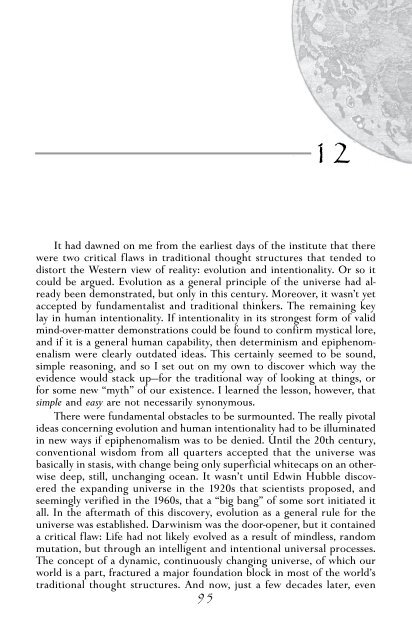edgar-mitchell
edgar-mitchell
edgar-mitchell
You also want an ePaper? Increase the reach of your titles
YUMPU automatically turns print PDFs into web optimized ePapers that Google loves.
48<br />
The Way of the Explorer<br />
the brain, the software and firmware programs analogous to the mentality<br />
that used the machine. Though brain evolution takes place on cosmic<br />
timescales, computer simulations of both computer and mental processes<br />
were progressing so rapidly that it would startle any eye that was open to<br />
observe. Though we did not recognize it then, humankind was going into<br />
space primarily to discover itself.<br />
In December of 1968, we took that first step into deep space when<br />
Frank Borman, Jim Lovell, and Bill Anders left Earth orbit for the first<br />
time in human history, and struck out for the moon with the intention of<br />
orbiting that luminous gray world and returning safely to Earth. The timing<br />
of that flight was hurried, as there was new intelligence suggesting that<br />
the Soviets were ready to send men to the moon as well. Nevertheless, this<br />
was the first human foray into deep space. Seven months later, after the<br />
two additional build-up flights of Apollo 9 and 10, Neil Armstrong and<br />
Buzz Aldrin both set foot on the lunar surface, with Michael Collins minding<br />
the store above them. In July of 1969, men were walking on another<br />
world for the first time in the history of our civilization—or any civilization,<br />
as far as we knew. When Armstrong announced to the world that the<br />
eagle had landed, it was tantamount to that unceremonious yet monumental<br />
flop of the first sea creature that beached itself on dry land, and lived.<br />
Through the course of a few hundred thousand millennia, creatures of all<br />
description would then roam the forest, plains, and deserts, because the<br />
sea from which they sprang was no longer suitable for their kind.<br />
So it seemed, and so it is, that humankind was embarking on an adventure<br />
that would take them throughout the cosmos, just as those first<br />
amphibians had led living matter throughout the dryer parts of the home<br />
planet. More than a quarter of a million miles away, as the astronauts’<br />
images were being transmitted from that rocky, dead world, the inhabitants<br />
of Earth seemed to grasp the weight of this notion, either consciously<br />
or unconsciously, and the astronauts themselves sensed the audience<br />
through the immense and empty distance. Giving weight to this assertion<br />
is the fact that during the intervening years since the moon landings, the<br />
photographs of Earth taken from deep space continue to appear daily on<br />
the pages of Earthbound periodicals and television, to stir in each of us a<br />
deeper sense of the larger reality.<br />
Soon after becoming America’s first man in space on the historic<br />
15-minute flight of Freedom 7, Al Shepard had been grounded due to the<br />
diagnosis of an inner-ear disorder that caused nausea, vomiting, and a sense<br />
of vertigo, known as Meniere’s syndrome. For many sufferers of the disorder,<br />
the symptoms clear up on their own, but for most there was little to


